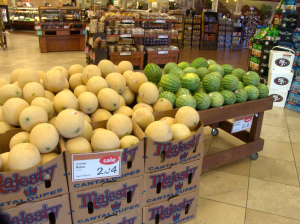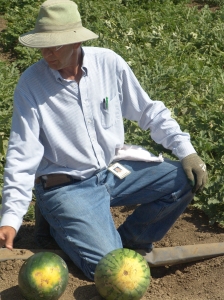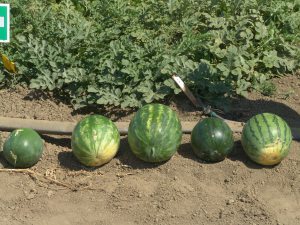
If there is one thing we can all agree on it’s that food is a good thing. Food is what provides our bodies with the vitamins, nutrients, carbohydrates and proteins that fuel our daily lives. James Beard said, “Food is our common ground, a universal experience.” Former cook, food writer and snarkicist, Anthony Bourdain says that knowing people’s food is a start to understanding them:
“If I'm an advocate for anything, it's to move. As far as you can, as much as you can. Across the ocean, or simply across the river. The extent to which you can walk in someone else's shoes or at least eat their food, it's a plus for everybody. Open your mind, get up off the couch, move.”On Saturday, August 9, 2014, I did more than get off the couch, I got out of bed early and moved, driving south on Interstate 5 to Monsanto’s research and development facility in Woodland, CA. I arrived right at 9:01AM. Their facility is a big place, the main building alone covers more than two acres. At the Woodland facility they have 6.7 acres of greenhouses and screen houses, 182 acres of land plus 200 acres of land that they lease. They grow many different plants for markets all over the world at the Woodland R&D:
- Solaneous - Eggplant, hot pepper, sweet pepper, tomato
- Cucurbits - cucumber, melon, pumpkin, squash, watermelon
- Root and Bulb - Carrot, leeks, onion
- Large Seed - Garden beans, sweet corn, dried beans, peas
- Brassica- Broccoli, cabbage, Chinese cabbage, cauliflower, radish
- Leafy - Fennel, lettuce, spinach
We’re a company committed to creating holistic solutions to the big challenges facing agriculture. We currently provide seeds for fruits, vegetables and staples like corn and soybeans that can help fight off disease, pests and drought, which can wipe out harvests. We develop crop protection products to help keep crops safe from attacks. And we’re collecting and finding new ways to use data to solve day-to-day problems on the farm, such as tracking weather conditions in the fields and finding the optimal times for watering….That last sentence about partnering with farmers is an important one. You and I, the Joe and Josephine Public’s of the world are not the primary customers for Monsanto. Nor are we for their competitors: Syngenta and Bayer CropScience AG, nor for the dozens (perhaps hundreds) mid-sized seed companies worldwide. Monsanto, et. al., strives to meet the needs of their customers: farmers.
Monsanto began in 1901 as a company that created artificial sweeteners. Between the 1950s and 1980s, we pioneered many agricultural innovations including breakthrough fertilizers, crop protection tools and advances in plant genetics. In 2002, Monsanto Company was re-established as an independent agricultural company, with pharmaceutical business units forming a separate entity. Today, we partner with farmers around the world in order to sustainably produce more food.
There’s a huge difference between a hobby and a livelihood. Farming is a serious business. If I dink around in the garden on weekends, and a pest takes out my peas, beans, tomatoes, or other fruit or vegetable, I can shrug my shoulders and run down to the market.
If I am a farmer, and that crop represents next year’s mortgage payments, clothing, transportation money, food, entertainment, and medical bills, such a loss to a farmer can devastate the family. That is not to say that companies such as Monsanto don’t care about looks, texture, or taste, but their customers drive their focus.

Bill Johnson, PhD, talked about squash breeding and the crops' odd market.
Farmers need to have seed to meet their customers (again, it's not you or me, it's the distributors) needs, and they have dozens of seed companies to choose from. Monsanto is by no means the only company to choose from. They have to compete for the chance to sell their seed to a farmer. One fascinating bit of information I picked up on this is the cultural differences around the world for food crops.
Different places around the world have different tastes and aesthetics. The company cannot have just one kind of squash variety but perhaps dozens. And then there are the size and shipping preferences. If Monsanto does not have the seed to meet the needs of the farmer in the U.S., Chile, Israel, Honduras, Ecuador, and elsewhere, each farmer in those places will buy seed from someone else.
And farmers will often buy from several seed companies depending on the growing season and their own needs.
Many critics think Monsanto wants to poison consumers, which is a very odd business model when you stop to think about it. The poisoning comes from the use of transgenic biotechnology--GMOs (according to critics).
Yet of all the fruit and vegetables I and my fellow bloggers saw only one squash which had been created transgenically, twenty years ago to resist a virus. Resistance to GMOs, in my opinion, has forced Monsanto and others to revert to the far more cumbersome method of crossing and back-crossing plants rather than selecting and placing beneficial genes. Under the cross/back-cross system the fastest a product can get to market is six years, but there is no EPA or FDA hoop to jump through.
Transgenic plants could be developed much, much faster but the regulatory hoops can add decades to the rollout to market. Food is important. By 2050, the world population will be two billion more than today's (after which it is projected to level out and then fall). If we want to create more wild places and not increase our agricultural footprint then we need to have more plants that can pull nitrogen from the air as legumes can; we need plants that are more drought and flood resistant.
We need plants that can provide greater vitamins and minerals (since not everyone in the world will be able to eat or afford a balanced diet). Without the ability to use transgenic technology, our chances of bio-fortification are nil and the other needs very nearly nil.
“Civilization is running a race with famine,” soil scientist, Walter Clay Lowdermilk wrote, “and the outcome is very much in doubt."Monsanto shows that they take food race seriously. Why critics of biotechnology think we ought to run that race in the technological equivalents of gunny sacks makes no sense. My thanks to Janice Person, Monsanto's Online Engagement Entrepreneur, for inviting me.
Also a big thank you to Holly Butka, Global Consumer Engagement Director, Tom Wofford, PhD, Brassica and leafy Breeding Director; Jeff Mills, PhD; Bill Johnson, PhD; Greg Tolla, PhD; and Alan Krivanek for taking time out of your Saturday.

After tasting incredible melons Alan Krivanek, PhD, tries to interest us in, my personal fruit fav, tomatoes.

Janice Person positions herself for a photo.

Jeff Mills, PhD, explained melon breeding.

Greg Tolla, PhD, explains that cultures have differing wants in watermelons. Different cultures like different characteristics in their fruits and veg.

Just a few of the watermelons (cousins of the cucumber) showing different characteristics.
Disclaimer: I was provided a travel stipend by Monsanto to offset transportation costs to and from the Woodland Monsanto blogger tour. No other compensation was received. All opinions expressed are my own.



Comments